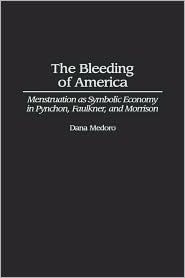 Guest Post by David Linton, Marymount Manhattan College
Guest Post by David Linton, Marymount Manhattan College
Dana Medoro, The Bleeding of America: Menstruation as Symbolic Economy in Pynchon, Faulkner and Morrison, Greenwood/Praeger, 2002. Pp. 198. $98. ISBN 0313320594.
One of the ways the taboos surrounding menstruation find expression is through absence. For instance, until recently menstrual references in American novels were rare. Contemporary writers, particularly women novelists such as Joyce Carol Oates (The Tattooed Girl, 2003) and Erica Jong (Parachutes and Kisses, 1984) and occasional men such as John Updike (The Widows of Eastwick, 2008) and Philip Roth (The Dying Animal, 2001), have more frequently used period reference to advance a plot or to symbolize something or other, but historically the menstrual cycle has generally been off limits. Similarly, literary criticism has tended to ignore or avoid an examination of the social, cultural and psychological significance of the cycle within the literary marketplace. There is, however, in the area of scholarship one significant exception.
In 2002 Dana Medoro published a seminal study of menstrual references and symbolic allusions titled, The Bleeding of America: Menstruation as Symbolic Economy in Pynchon, Faulkner and Morrison.
Here’s the way the publisher describes the book:
Working from the premise that the Puritan construction of America as a return to Eden endures into American literature of the 20th century, Medoro focuses on the rhetoric of cyclical regeneration, blood, and damnation that accompanies this construction. She argues that a semiotics of menstruation infuses this rhetoric and informs the figuration of a feminine America in the nation’s literary tradition: America, as a New World Eden, is haunted not only by the Fall, but also by the “Curse of Eve.” The book examines how 9 novels by Pynchon, Faulkner, and Morrison link variations on the figure of the menstruating woman to the bloody history of the United States and to a vision of the nation’s redemptive promise.
Since publication of The Bleeding of America, Medoro has continued to explore the rich potential of menstrual symbolism in fiction as part of a presentation at the Modern Language Association where she deconstructed the levels of meaning in the many bleeding occurrences in Stephen King’s Carrie and later on in her reexaminations of Hawthorne’s The Scarlet Letter. Her work stands as an outstanding example of how deeply embedded are aspects of the cycle in every facet of cultural expression.

